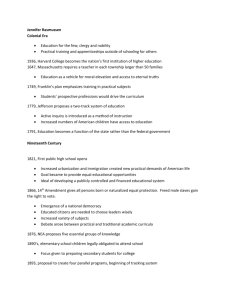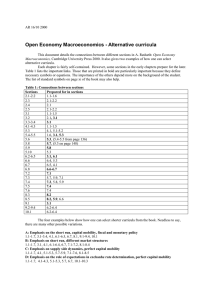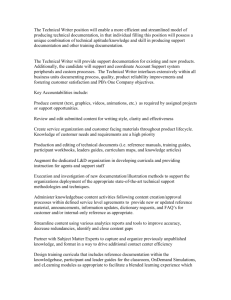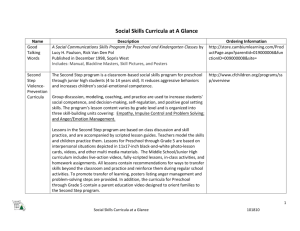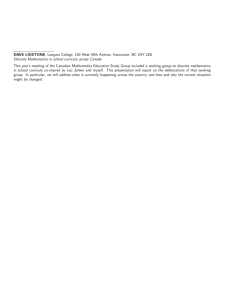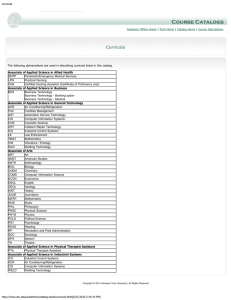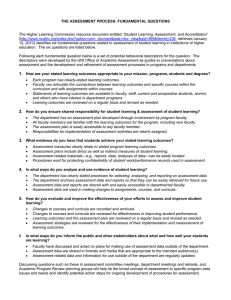The Diferencies between Curricula with the Focus on the Subject... Curricula with the Focus on the Situation
advertisement
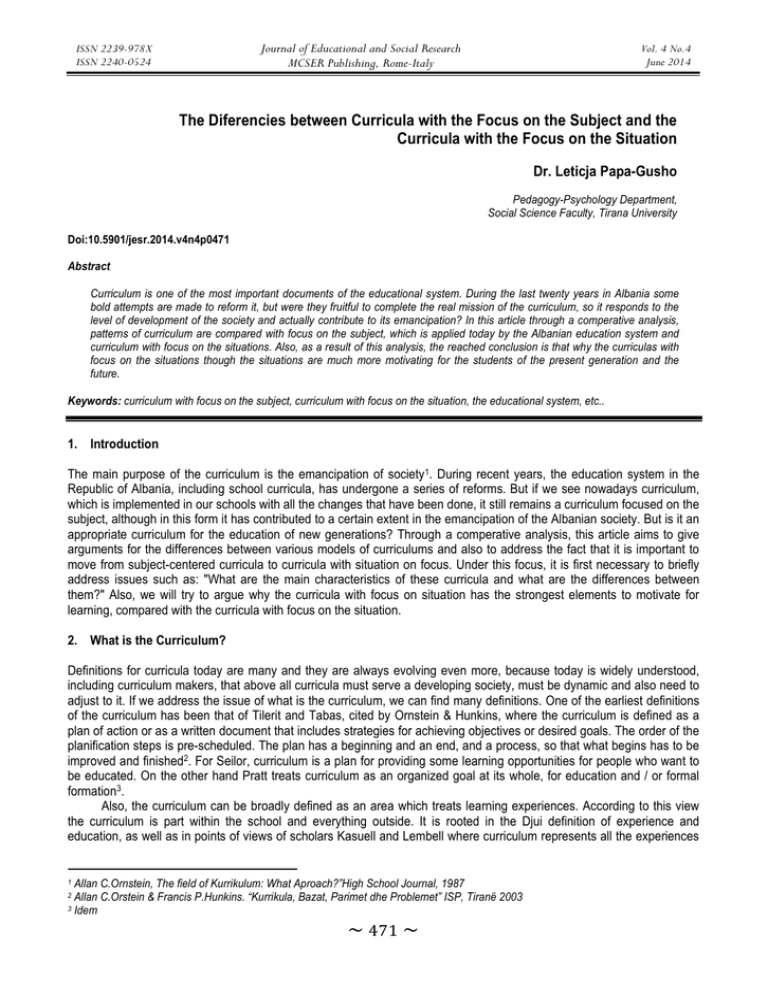
Journal of Educational and Social Research MCSER Publishing, Rome-Italy ISSN 2239-978X ISSN 2240-0524 Vol. 4 No.4 June 2014 The Diferencies between Curricula with the Focus on the Subject and the Curricula with the Focus on the Situation Dr. Leticja Papa-Gusho Pedagogy-Psychology Department, Social Science Faculty, Tirana University Doi:10.5901/jesr.2014.v4n4p0471 Abstract Curriculum is one of the most important documents of the educational system. During the last twenty years in Albania some bold attempts are made to reform it, but were they fruitful to complete the real mission of the curriculum, so it responds to the level of development of the society and actually contribute to its emancipation? In this article through a comperative analysis, patterns of curriculum are compared with focus on the subject, which is applied today by the Albanian education system and curriculum with focus on the situations. Also, as a result of this analysis, the reached conclusion is that why the curriculas with focus on the situations though the situations are much more motivating for the students of the present generation and the future. Keywords: curriculum with focus on the subject, curriculum with focus on the situation, the educational system, etc.. 1. Introduction The main purpose of the curriculum is the emancipation of society1. During recent years, the education system in the Republic of Albania, including school curricula, has undergone a series of reforms. But if we see nowadays curriculum, which is implemented in our schools with all the changes that have been done, it still remains a curriculum focused on the subject, although in this form it has contributed to a certain extent in the emancipation of the Albanian society. But is it an appropriate curriculum for the education of new generations? Through a comperative analysis, this article aims to give arguments for the differences between various models of curriculums and also to address the fact that it is important to move from subject-centered curricula to curricula with situation on focus. Under this focus, it is first necessary to briefly address issues such as: "What are the main characteristics of these curricula and what are the differences between them?" Also, we will try to argue why the curricula with focus on situation has the strongest elements to motivate for learning, compared with the curricula with focus on the situation. 2. What is the Curriculum? Definitions for curricula today are many and they are always evolving even more, because today is widely understood, including curriculum makers, that above all curricula must serve a developing society, must be dynamic and also need to adjust to it. If we address the issue of what is the curriculum, we can find many definitions. One of the earliest definitions of the curriculum has been that of Tilerit and Tabas, cited by Ornstein & Hunkins, where the curriculum is defined as a plan of action or as a written document that includes strategies for achieving objectives or desired goals. The order of the planification steps is pre-scheduled. The plan has a beginning and an end, and a process, so that what begins has to be improved and finished2. For Seilor, curriculum is a plan for providing some learning opportunities for people who want to be educated. On the other hand Pratt treats curriculum as an organized goal at its whole, for education and / or formal formation3. Also, the curriculum can be broadly defined as an area which treats learning experiences. According to this view the curriculum is part within the school and everything outside. It is rooted in the Djui definition of experience and education, as well as in points of views of scholars Kasuell and Lembell where curriculum represents all the experiences Allan C.Ornstein, The field of Kurrikulum: What Aproach?”High School Journal, 1987 Allan C.Orstein & Francis P.Hunkins. “Kurrikula, Bazat, Parimet dhe Problemet” ISP, Tiranë 2003 3 Idem 1 2 ~ 471 ~ ISSN 2239-978X ISSN 2240-0524 Journal of Educational and Social Research MCSER Publishing, Rome-Italy Vol. 4 No.4 June 2014 that children benefit under the guidance of teachers4. Also, according to Bejta, curriculum is a pedagogical project, in which all elements of learning are fully designed in an educational institution or training: Expected outcomes of learning, goals, content, strategies, technologies and learning environments as well as control of evaluation of reached results5. 3. The Model Focused on the Subject and the Model Focused on the Situation The model focused on the subject is the oldest and the most renowned by teachers as well as by ordinary people. This model is maybe the most extended one because it relies on textbooks and on the fact that teachers who treat the subject matter are real specialists. In this model, the curriculum is organized in a way in which basic knowledge is developed in different subjects. With the explosion of knowledge and its profiles, its divisions have grown in number and profiles. Such an arrangement of the content of the curriculum is supported by the view that the best subjects discussed in textbooks. Here the teacher has an active and dominant role. The lecture, verbal communication and large group discussion are the main techniques used in this learning model. The discussion moves from simple ideas to complex ones6. According to the followers of this model, since learning is primarily a verbal activity, knowledge and ideas are stored and communicated better in this kind of format. The advantage of this model is that it introduces students to the basic recognition that society possesses and the model can be delivered easily because in the market for books and materials are found additional enhancements. Tradition is also with this model, because people have attended schools that have used this well recognized format. On the other hand, between the diversity of the types of curricula used in the world today, it is also the model focused on the situation, which is a subtype of the model focused on the problem. This model is based on the problems of living and perceived realities for the individual and for society in general. This model reinforces cultural traditions and addresses those needs of the community and society that are not yet met.7 The Model with life situations has in its foundation three main theses. First, continued living situations are crucial for the successful functioning of society, therefore organizing a curriculum for them has a lecture logic. Second, students come to see the importance of what will direct the study, if the content is organized around aspects of community life. Finally, by studying social and life situations, students will study ways to improve society and will be directly involved in this improvement.8 According to Stretmajer, Frokner and McKim, curriculum for modern living, supported by living situations, should contain three major blocks that are the intellectual growth, increased social participation and the capacity to deal with facts and environmental forces. Block the growth of intellectual abilities involving situations that require increased ability to meet health needs, situations that require increased capabilities of intellectual capacity utilization, situations that require increased ability of responsibility for moral choices and situations requiring increased ability to meet the needs for expression and aesthetic appreciation. In the block of increased social participation, are included situations that require increased capabilities for interaction with others, situations that require increasing the ability of responsible participation as a member of the group and between groups and the third block, in increased ability to 'deal with facts and environmental forces, are involved situations that require increased ability to deal with natural phenomena, increased skills to deal with technological resources and increased capabilities to deal with structures and economic, social and political forces.9 4. Differences between the Model Focused on the Subject and the Model Focused on Situation Fundamental changes that are observed in these models are differentiated on all the psychological bases on which they rely. Curriculum which is subject centered, in a large part relies on behaviorist learning process where the student learns by doing and observing others, where strengthening is essential for the realization of learning, where the practice of information improves learning and memory, which are crucial for the periodic memorizing information, where learning through reward is more pleasurable than learning through punishment, where the learning process goes from simple Idem Bejtja, P. “Rreth konceptit “kurrikul” në arismin parauniveristar”. Buletin “ Arsimi dhe formimi profesional”, Nr 3, 2003,cituar nga Karameta, P. “Arsimi i Gjeneratës Tjetër” Sara, Tiranë 2014 6 Allan C.Orstein & Francis P.Hunkins. “Kurrikula, Bazat, Parimet dhe Problemet” ISP, Tiranë 2003 7 Idem 8 J.C.Mancall,E.Lodish & J.Springer, “Searching Across the Curriculum”, Phi Delta Kapplan(1992) 9 F.B.Stratemeyer, H.L.Forkner & M.G.McKim, “Developing a Curriculum for Modern Living, New York: Teachers College Press, Columbia University, 1947, cituar nga Allan C.Orstein & Francis P.Hunkins. “Kurrikula, Bazat, Parimet dhe Problemet” ISP, Tiranë 2003 4 5 ~ 472 ~ ISSN 2239-978X ISSN 2240-0524 Journal of Educational and Social Research MCSER Publishing, Rome-Italy Vol. 4 No.4 June 2014 behavior on complex behavior and from Partial behaviour to full behavior, where learning should be implemented piece by piece and step by step, where learning takes place as a hierarchical process and based on the continued willingness, where learning results should be announced in advance through objectives and where learning is observable and measurable. Organization of classroom activities in this type of curriculum, is based in activities where the teacher is in the middle, is the authoritative role, has very high grip on the student and on the other hand, the student has very little autonomy prevails supervision and external rewards.10 On the other hand, curricula based on the situation, has its psychological basis in learning as cognitive-developmental and humanistic skills where students are important, where learning can can be modified as a result of interaction with the environment itself, where the Learning involves the assimilation of new experiences along with previous experiences, where learning is best achieved through active participation in the environment where the teacher can stimulate environment for learning, where students learn best when they arrive to generalize information and learn how to learn. Also considered as a comprehensive learning and not just cognitive, where the act of learning involves emotions, feelings and habits of interdependent motors, where learning relies heavily on the interactions of warm, friendly and democratic among students, where quality and learning processes regarded as more important than the quantity or its products, where students share ideas, work together and guide and help each other, where homogeneous grouping, academic leadership and competitive programs are minimized and learning is based on life experiences, discovery, research and experiment. Classroom activities in such curricula are based on the autonomy of decision-making by students and where the center of all learning activities the student is him/herself. Also, there are other differences between these two types of curricula.11 Thus, the curriculum with focus on subject has no contextualize content, broken down into mikrothesis and organized one after the other, from the simple to the complex, measured observable behavior of students is based on the transmission of subject content instruction, students are passive listeners and reproduce content without contextualized to specific subjects or disciplines, which are generally not related to previous experiences.12 While curricula with focus on the situation has class of situations and specified situations adapted to target education, where handling situations in a competent and accomplished based on the actions and experiences of students to build new knowledge and develop competencies, there are variety of sources contextualized, among subjects and understood by pupils at the end of schooling and the expectations are that the student will become competent to handle situations in classes.13 5. Which of the Two Curricula is more Motivating for the Students? Class research in contexts related to the development of students' achievement motivation and mastery of competencies are focused on a variety of factors, including the types of tasks used, the structures of authority and autonomy as well as cognitive and evaluative systems. Some scholars have argued that student motivation and engagement, can grow in classrooms where tasks are authentic, which provided opportunities for students to assume leadership, which allowed students to work in a cooperative and allowed various forms of talent development.14 Using different tasks, with full understanding promotes thought sufficiently challenging goals orientations tenure situation.15 Challenging tasks may also be important in creating environments that support classes perceptions of competence, after success in more challenging tasks in light tasks are likely to support higher levels of efficiency and competence.16 Situations involving imagination, innovation and elements of uncertainty could increase internal motivation.17 Structures of authority to teachers and students in the classroom autonomy are critical to the achievement motivation as in terms of values orientations, as well as those goals. As for values, Deci and Ryan suggested that providing students with choices and less control from the outside helps to support the students' needs for selfAllan C.Orstein & Francis P.Hunkins. “Kurrikula, Bazat, Parimet dhe Problemet” ISP, Tiranë 2003 Idem 12 Karameta, P. “Arsimi i Gjeneratës Tjetër: Konstruktivizmi, Kurrikula, Kompetenca.” Fq 160,Sara, Tiranë (2014) 13 Karameta, P. “Arsimi i Gjeneratës Tjetër: Konstruktivizmi, Kurrikula,Kompetenca.”Fq 178, Sara, Tiranë (2014) 14 Blumenfield, P.,C Soloways,E.,Marx,R.,Krajcik,J., “Motiavating Porject based Learning:Sustaining the doing, supportingthe learning”. Educational Psychologist. (1991) Vol 26 15 Ames, C. “Clasrooms goals, structures and students motivation”. Journal of education Psycology. Cituar nga Garcia.L &Fredericks.J “Developmental Perspectives on Achievment Motivation” (2008) 16 Pintrich,P.R., & Schunk,D. “Motivation in Education:Theory,Research, and application” Upper Saddle River,NJ:Merrill (2002) 17 Idem 10 11 ~ 473 ~ ISSN 2239-978X ISSN 2240-0524 Journal of Educational and Social Research MCSER Publishing, Rome-Italy Vol. 4 No.4 June 2014 determination and thereby foster internal motivation. In contrast, the perception of strong controls (and low autonomy) in the form of Deadline's, surveillance and external rewards is likely to undermine internal motivation.18 High levels of autonomy and lower levels of authority are also critical to create a structure possessing class goals. When teachers allow students more control in the classroom, students get the message that the importance and appreciation for participation in an activity are best for them, rather than to please their teachers or to demonstrate their competence.19 On the other hand other researchers, found evidence supporting the link between autonomy-class authority and achieving goals by mastering the competencies of students. They found that the classes were perceived as more oriented toward mastering skills when students participated in drafting the rules, when the rules autonomy support (eg, students were free to speak as long as he talks about the work), and when students have more options in terms of daily routine. Of course, one must also consider that some form of autonomy support may be more significant than other forms, with the support of cognitive autonomy in which students were given control to learn through practices such as encouraging strategies Multiple solving a problem or accepting multiple solutions leading to higher levels of motivation and commitment than autonomy support for classroom procedures and organization20 6. Conclusions In conclusion, at the end of this paper should summarize today's technological era at its peak of ripeness and this era has affected many strong differences of all aspects of life, be they economic, social and political. Curriculum as a foundation document for an educational system which should make students able to function in this new reality, to solve the general situation and special life in this global society. Also, focus on life situations, the focus is on solving the problem, which process and content integrated with some success in curricular experience. Despite the fact that students can not directly focus on the content, a strong point of this model is that content is organized in ways that allows students to observe clearly the problems and become stakeholders in their resolution. Also, this model uses the experiences of past and present students as a means to make them capable and competent to analyze basic areas of life. In these conditions, the application of situations at school by students before they enter the world of work and to take responsibility as adults, helping them become more skilled and more competitive in this global society where we are trying to integrate. Reference Allan C.Ornstein, The field of Kurrikulum: What Aproach?” High School Journal, (1987) Allan C.Orstein & Francis P.Hunkins. “Kurrikula, Bazat, Parimet dhe Problemet” ISP, Tiranë (2003) Blumenfield, P., C, Soloways, E., Marx, R., Krajcik, J., “Motivating Project based Learning: Sustaining the doing, supportingthe learning”. Educational Psychologist. (1991) Vol 26 Deci, E., L & Ryan, R.M. Extrinsic rewards and intrinsic motivation in education: Reconsidered once again. Review of Educational Research. (2001) Garcia.L &Fredericks.J “Developmental Perspectives on Achievement Motivation” Handbook of Motivation. (2008) J.C.Mancall, E.Lodish & J.Springer, “Searching Across the Curriculum”, Phi Delta Kapplan (1992) Karameta, P. “Arsimi i Gjeneratës Tjetër: Konstruktivizmi, Kurrikula, Kompetenca.” Fq 160, Sara, Tiranë (2014) Pintrich, P.R., & Schunk, D. “Motivation in Education: Theory, Research, and application” Upper Saddle River, NJ: Merrill (2002) Deci, E.,L & Ryan,R.M. Extrinsic rewards and intrinsic motivation in education: Reconsidered once again. Review of Educational Research. (2001) 19 Idem 20 Stefanou, C.R., Perencevich, K.C., DiCintio, M. & Turner, J.C.Supporting autonomy in the classroom: Ways teachers encourage students decision making and ownership. Educational Psychologist, Vol 39 (2004). Cituar nga Garcia.L &Fredericks.J “Developmental Perspectives on Achievment Motivation” (2008) 18 ~ 474 ~
